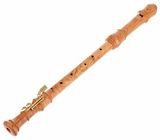I chose the more expensive olive wood option because of its beauty and fairly brilliant tonal qualities. The wood is relatively light in colour and weight but it is quite hard and has a rather pleasant smokey smell. The grain lines up perfectly down the length of the recorder indicating that it was constructed from a single block of wood. The wood is wax impregnated. Nevertheless I gave it a light coating of sweet almond oil to prevent any oils or grease from my fingers darkening the wood around the finger holes.
The woodwork and bore are very well finished, the outside smooth and matte. The C / C# keys work well. The tenons are cork jointed, which I prefer. I have fairly average male hands and find the finger-holes an easy stretch. My only criticism of the build is that the thumbhole is not bushed, though that can easily be done after purchase.
I chose the Küng Superio because, although essentially a baroque recorder, it is has an extended range of 2 octaves and a fifth. In practice I find it relatively easy to play the full range, notwithstanding I am at an early stage of playing the instrument in. However, in the upper register particularly, the fingerings recommended by Küng, which work very well, are slightly different to conventional fingering. This is something one should be able to quickly adapt to. Tonally there is the characteristic plaintiveness of the tenor recorder,but, given sufficient though not excessive air, the tone can be surprisingly bright and assertive. There is sufficient resistance to permit subtle tonal shading and the tuning is generally very good. The Superio can thus function either as a solo instrument or as a consort instrument. I am very satisfied with the sound and build quality.
The instrument is presented in the usual, excellent, hard, zipped Küng case of textile and leather.
The instrument is strongly recommended for serious consideration.


